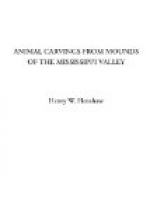It may be premised that the writer undertook the examination of the carvings with no theories of his own to propose in place of those hitherto advanced. In fact, their critical examination may almost be said to have been the result of accident. Having made the birds of the United States his study for several years, the writer glanced over the bird carvings in the most cursory manner, being curious to see what species were represented. The inaccurate identification of some of these by the authors of “The Ancient Monuments of the Mississippi Valley” led to the examination of the series as a whole, and subsequently to the discussion they had received at the hands of various authors. The carvings are, therefore, here considered rather from the stand-point of the naturalist than the archaeologist. Believing that the question first in importance concerns their actual resemblances, substantially the same kind of critical study is applied to them which they would receive were they from the hands of a modern zoological artist. Such a course has obvious disadvantages, since it places the work of men who were in, at best, but a semi-civilized condition on a much higher plane than other facts would seem to justify. It may be urged, as the writer indeed believes, that the accuracy sufficient for the specific identification of these carvings is not to be expected of men in the state of culture the Mound-Builders are generally supposed to have attained. To which answer may be made that it is precisely on the supposition that the carvings were accurate copies from nature that the theories respecting them have been promulgated by archaeologists. On no other supposition could such theories have been advanced. So accurate indeed have they been deemed that they have been directly compared with the work of modern artists, as will be noticed hereafter. Hence the method here adopted in their study seems to be not only the best, but the only one likely to produce definite results.




